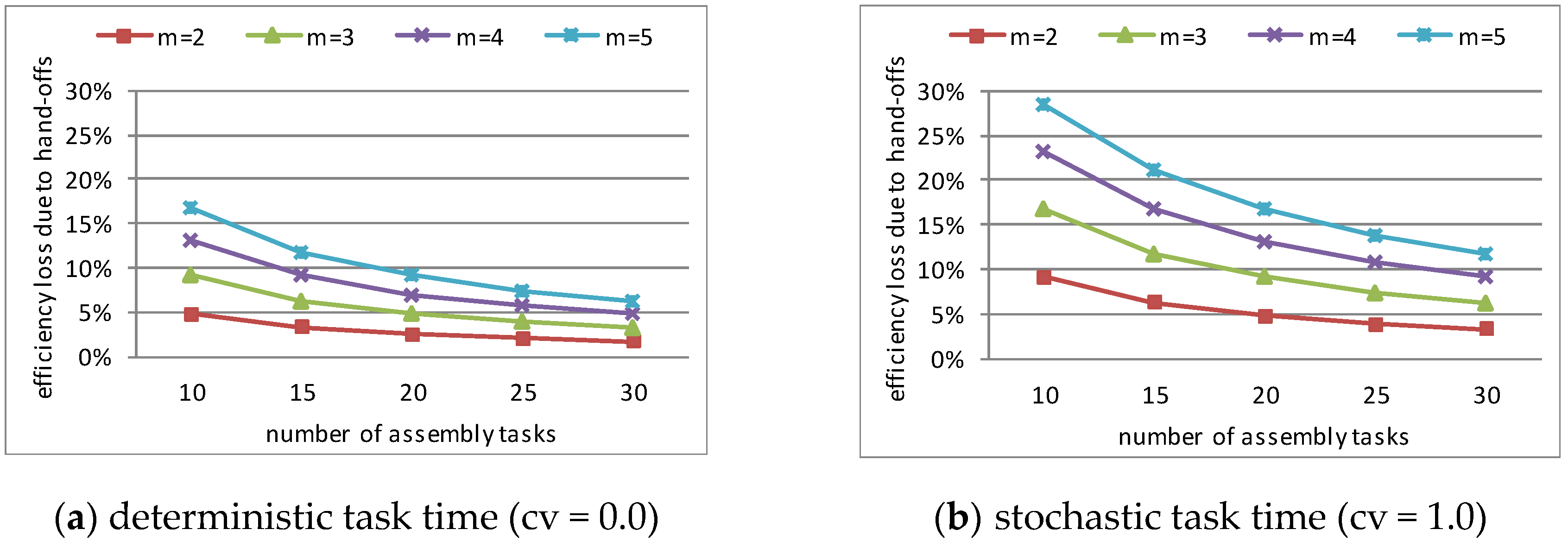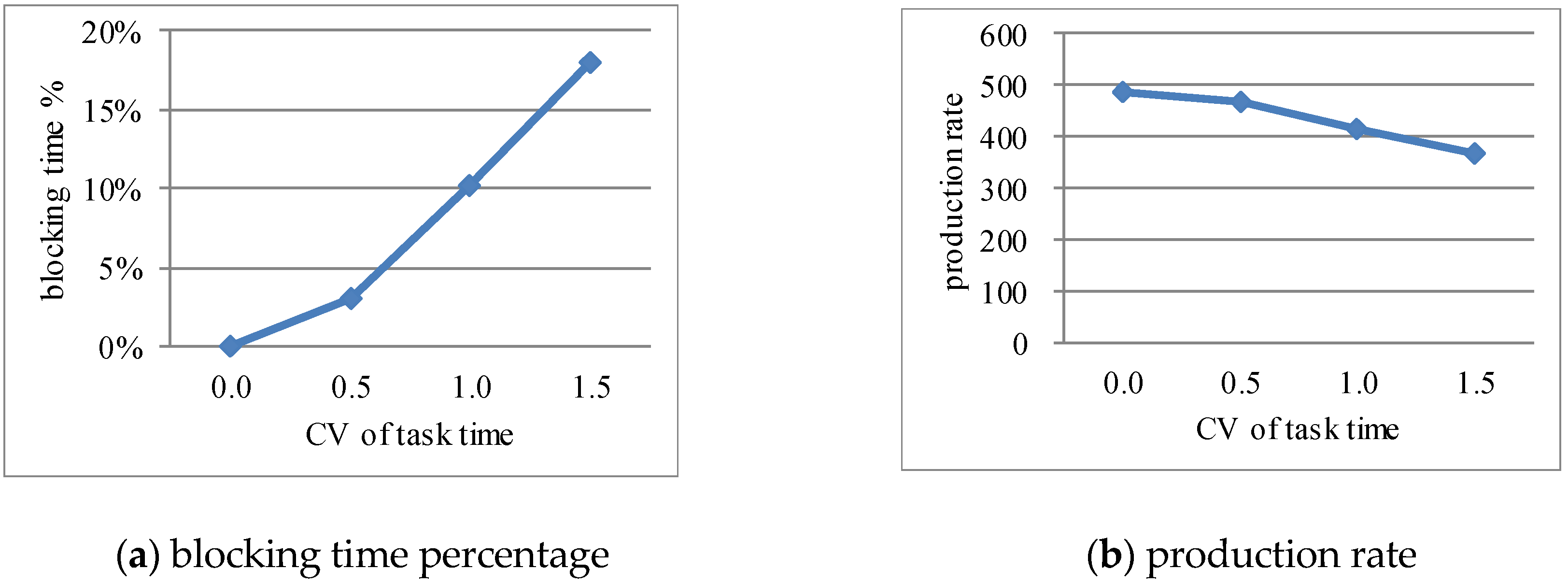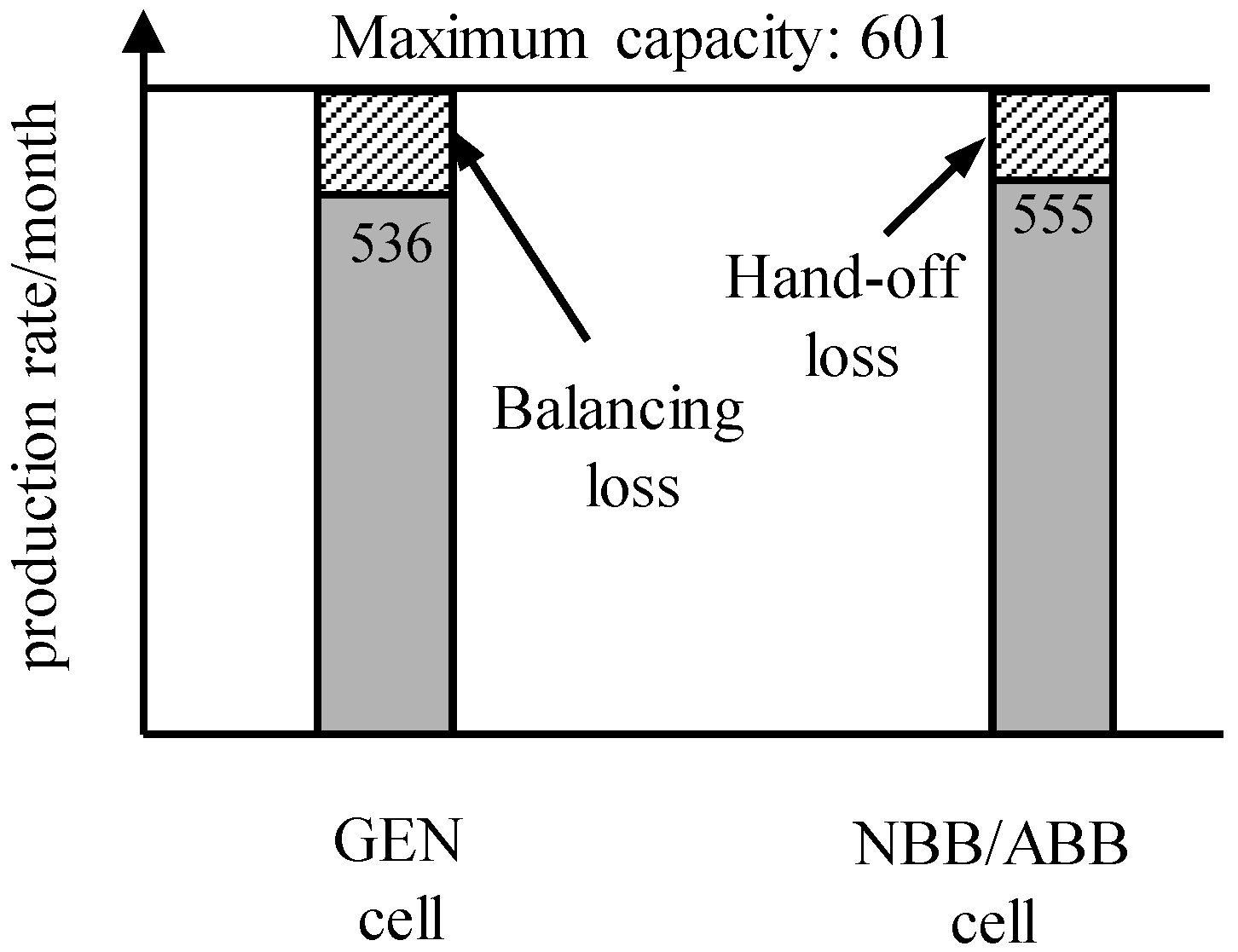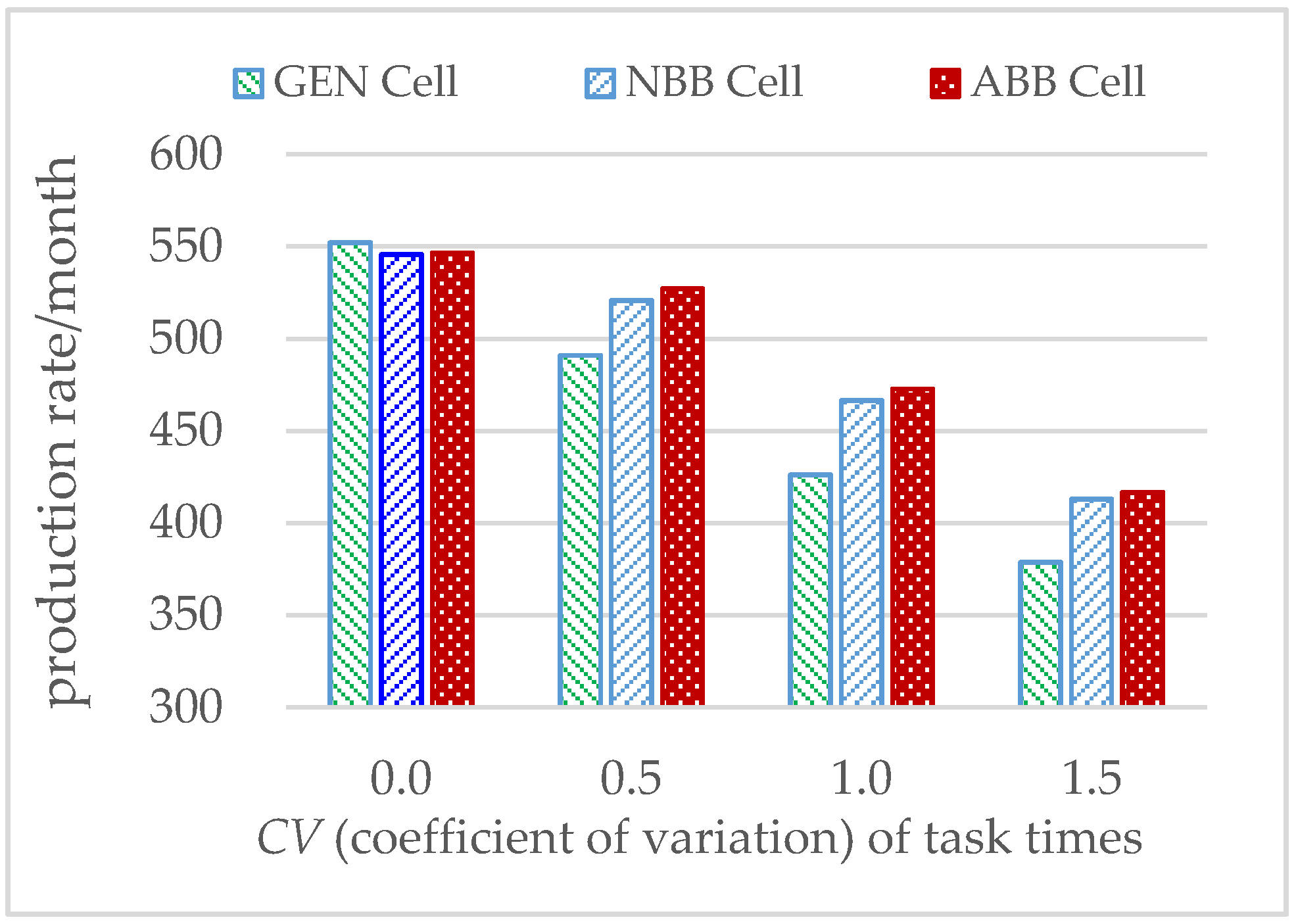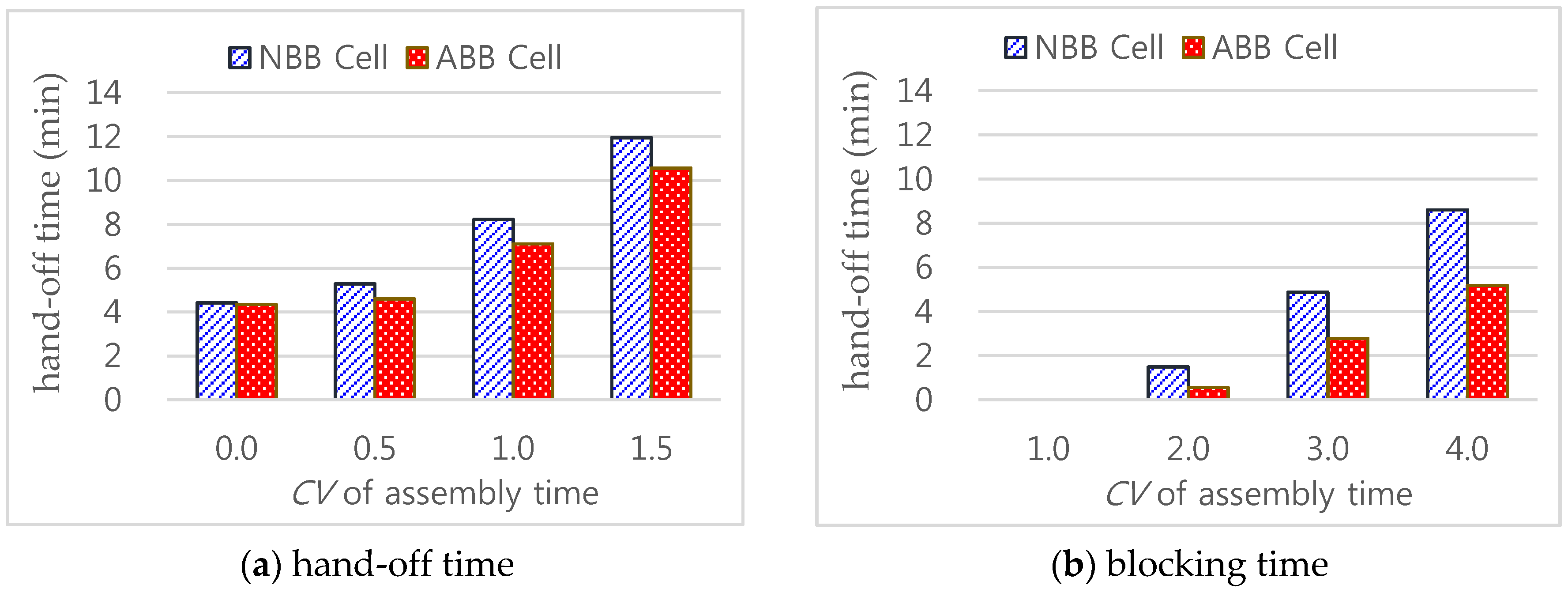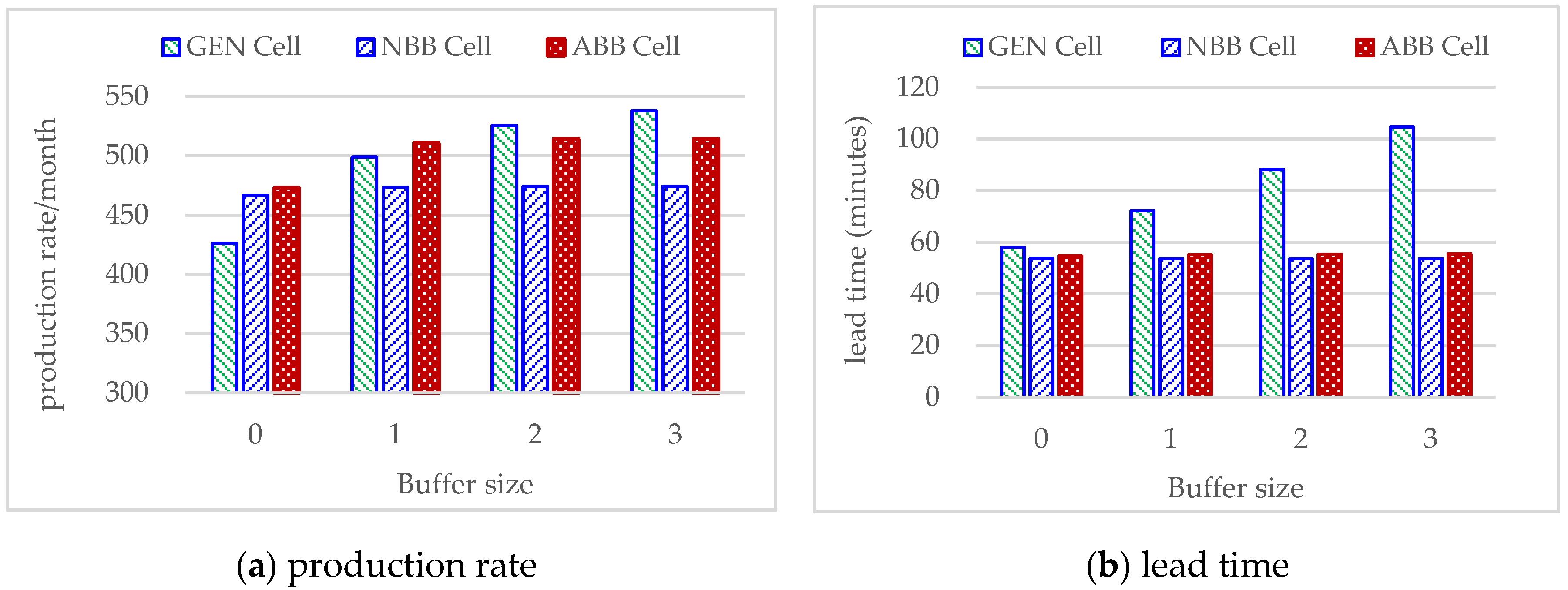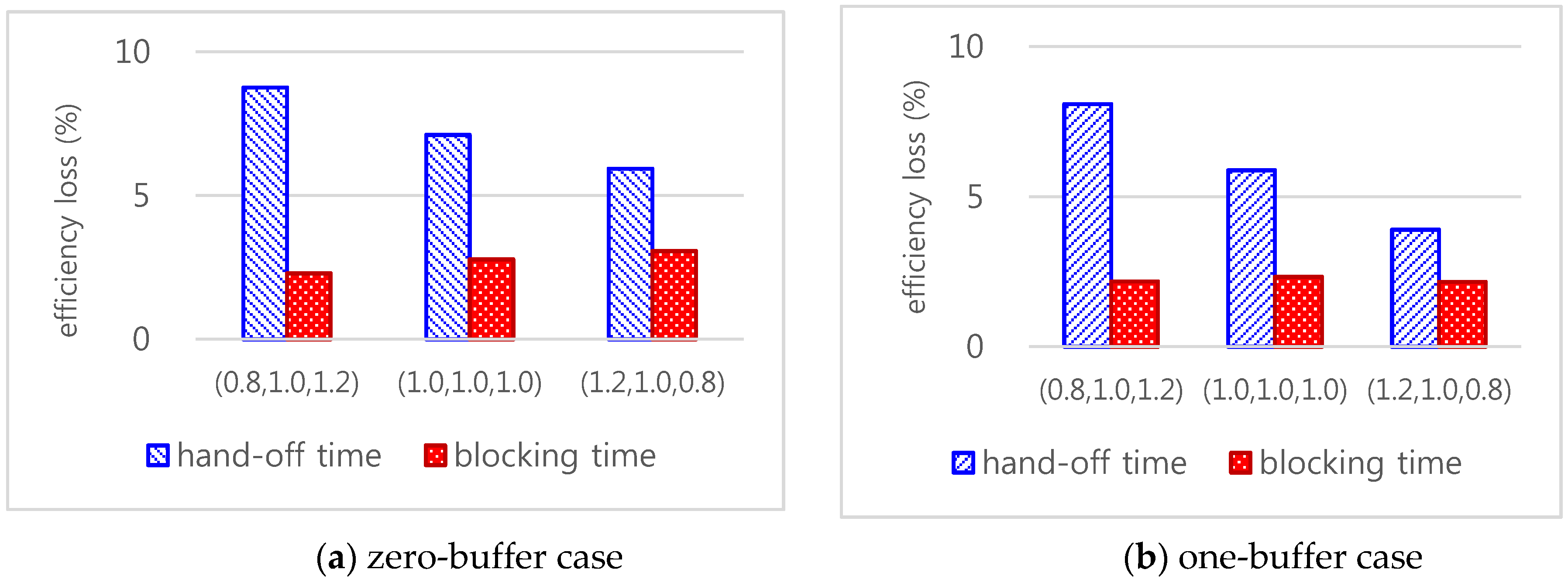1. Introduction
A common assembly system consists of m workers (or workstations) arranged along a production line. The components are fed into the line and progressively assembled as they move down from station to station. At a workstation k (= 1, …, m), a worker performs a set of assembly tasks, Sk, repeatedly. It takes station time, to complete all the tasks assigned to workstation k where tj is the assembly time for task j (=1,…, n). The cycle time, c, of the assembly line is determined by a bottleneck station whose station time is the largest, i.e., . The capacity of the assembly line is 1/c. When an assembly line is operated in a full capacity, station k with has an idle time of in each production cycle. Line balance efficiency E is defined by where . The assembly lines are widely employed in various industries for the production of standardized products.
One of the important decisions in the assembly line involves the work assignment regarding how much work to assign to each worker. Decisions about assembly task assignments are made through assembly line balancing (ALB) techniques whose key objective is to obtain a balanced assembly line by assigning assembly tasks to each worker as evenly as possible. The existing studies on ALB problems are well summarized in survey papers [
1,
2,
3,
4]. Most existing studies on ALB problems deal with a static line-balancing solution with which the workers perform a pre-assigned set of assembly tasks from cycle to cycle. In general, the ALB decisions are made at the early stage of the assembly line design process in which assembly time for an individual task is assumed to be constant. However, the real industrial environment is often different from the situations on which the ALB decisions are based. Manufacturing systems undergo various types of uncertainties including a machine breakdown, different worker skills, rework requirements, and quality problems. With the uncertainties, the assembly time fluctuates over time so that the assembly lines often fail to achieve the performance as expected [
5]. When a new product is introduced, which frequently happens in today’s fast-moving market, the assembly systems should be reconfigured. The frequent reconfiguration results in low performance in the traditional assembly line with a static task assignment. Moreover, it is common that the workers have different work speeds and each worker cannot perform assembly tasks at a constant speed throughout a day. When uncertainties are common, it has become more important for production systems to have the flexibility to respond quickly to uncertainties. Assembly cells have been introduced to solve these problems of assembly lines (e.g., [
6,
7,
8,
9]). A long assembly line is reconfigured into several small assembly cells in each of which a small number of workers (or a single worker in an extreme case) perform the entire range of assembly tasks for a final product. The assembly cells are now widely implemented in industries because they provide better manufacturing performance than traditional assembly lines in terms of productivity, product quality, and customer responsiveness. However, the assembly cell still has a workload balancing problem, especially under system uncertainty.
To solve the balancing problems associated with static task assignments, a new assembly line control method has been introduced where the idea of a bucket brigade (BB) is used as control logic in assembly lines [
10,
11,
12,
13,
14]. The BB-based assembly cell imitates a cooperative behavior of ants in nature, as shown in
Figure 1a. When some ant colonies find a large amount of food in one place, they move the food items to their nest in a collaborative way as follows [
15]: An ant carries her food item along the trail. When she encounters a downstream ant (i.e., an ant closer to the nest), she hands over the food item to the downstream ant and returns back toward the food source to move another food item. The recipient ant carries the food item further down the trail to the nest until she encounters an unladen ant (or the nest), and so on. In this control logic, the amount of work that an ant performs depends on her capability and system status (e.g., a road condition). Stronger ants can perform more tasks while weaker ants less.
Figure 1b shows a BB-based assembly cell. The following is how the BB-based cells work [
16]: “
Each worker assembles a product towards completion. Every worker except for the last one hands his current job over to his immediate successor (downstream worker) who is available and goes back upstream to take a new assembly job from his immediate predecessor (upstream worker). The last worker completes assembling all the remaining assembly tasks for a product, puts the final product in the output storage, and walks back upstream. After handing an assembly job over to his immediate successor, the first worker walks back to the beginning of the line to start a new assembly job.” The BB-based assembly cell is characterized as distributed and autonomous control. There is a reduced need for central planning and management because bucket brigades make the flow line self-balancing. The workers do not perform only the jobs previously assigned to them but perform the jobs that may be different from cycle to cycle. The balancing problems are mitigated by the self-balancing property. Each worker performs an assembly task with a velocity commensurate with his own capability. The throughput may be increased because bucket brigades spontaneously generate the optimal division of work. However, in real-world assembly operations, some situations undermine the performance of the BB-based cell. Two kinds of efficiency losses have been identified when the concept of the BB is applied to industrial systems: task hand-offs and worker blocking [
17]. Let us consider a BB-based assembly line in which each assembly task should be performed by only one operator without any interruption (i.e., the task is not divisible.) In this case, once a worker starts an assembly task on a product, he should complete the task. Then, it may happen that a downstream worker cannot take over an assembly task from the upstream worker immediately after he is available. Then, the downstream worker should wait (hand-off loss) until the predecessor finishes his current job. Moreover, the assembly time for a task is often not constant but variable over time. In this case, a situation may happen that an upstream worker cannot start a new assembly task (blocking loss) when his downstream worker is struggling to finish the same task.
This paper examines performance losses including hand-offs and blocking in the existing BB-based assembly cell and presents an improved version of the BB-based cell to reduce performance losses. The proposed system aims to enhance productivity by assigning assembly tasks to workers dynamically and possibly adding intermediate buffers for decoupling consecutive workers. The assembly systems under consideration have the following assumptions:
- −
A single type of product is assembled in the assembly system.
- −
Multiple elementary assembly tasks are needed to produce a final product.
- −
Each task is indivisible in assembly. A half-finished assembly task cannot be transferred to the downstream worker.
- −
Assembly time for a task may not be deterministic but stochastic with some variabilities.
- −
The sequence of assembly tasks is predefined on the basis of their precedence constraints.
- −
The sequence of the worker is fixed (no upstream worker can pass through his downstream worker).
- −
Two workers are not allowed to perform the same assembly task at the same time.
This paper is organized as follows.
Section 2 reviews the literature on previous studies on BB-based assembly systems. In
Section 3, we present the problems associated with efficiency losses in BB-based cells. A production capacity model in BB-based cells is introduced by considering hand-off and blocking delays.
Section 4 presents an improved version of the existing BB-based cell, and
Section 5 compares the performance of the new assembly cell with that of the other assembly systems through simulation experiments. Finally, we give concluding remarks in
Section 6.
2. Literature Review
Assembly line balancing (ALB) is a practical industrial problem that should be solved in many different industries. The main task of ALB decisions is to allocate elementary assembly tasks to workers (or workstations), typically intending to maximize line efficiency. As there are many different assembly environments, the research works on the ALB problems have extensions including multi-manned workstations [
18,
19], multi-product assembly lines [
20,
21], U-shaped assembly lines [
22,
23], asynchronous assembly lines [
24], and robotic assembly lines [
25]. Most existing studies deal with ALB problems by using optimization and/or heuristic models. The models provide static line-balancing solutions with which the workers perform a pre-assigned set of assembly tasks from cycle to cycle. Even though the optimization/heuristic models are expected to perform well under static manufacturing environments, high performance may not be realized under dynamic manufacturing environments.
A BB-based assembly cell has been introduced where assembly tasks are not assigned to a worker in a static way but can be performed by any worker [
16]. Each worker follows a simple control logic, which is discussed in
Figure 1b. The authors of [
16] claim that the BB-based system can achieve the highest productivity when the following three conditions are satisfied: (1) the walk-back time is ignorable, (2) the task can be handed over immediately when the downstream worker is available, and (3) each assembler
i = 1, …,
m is characterized by a distinct constant work velocity
vi. The work velocity for each assembler is deterministic. It is proved under the three ideal conditions that if the workers are sequenced along the flow line from slowest to fastest, the system becomes self-balanced such that the hand-offs between any two consecutive workers take place at a fixed location, and the production rate per unit time converges to
, which is the maximum attainable from the given workers [
16]. The problem is that the ideal conditions are not satisfied in most real-world production environments.
Reference [
26] shows that the BB-based system can be effective even in the presence of stochastic task times. Reference [
27] presents a case study where a traditional tractor assembly line was replaced by a BB-based assembly line. Here, walk-back times were explicitly considered. It is reported that the productivity increased by adopting the BB concept more than compensated for the time lost by walk-back times. Reference [
28] examined the effect of labor turnover on the performance of different assembly methods. A simulation study showed that the BB-based assembly line outperformed a traditional assembly line with fixed work allocation especially when the labor turnover rate was high. Reference [
10] explores how the BB protocol can be extended to make subassembly lines self-balancing where all the subassembly lines should be synchronized to produce at the same rate. Reference [
29] examined a two-worker BB system where one worker was faster than the other over some part of the production line and slower over another part of the line. Reference [
30] addresses blocking problems in a BB-based production system where blocking occurred only when the preceding worker was faster than the downstream worker. Deterministic task time was assumed. Initial positions of workers were identified where no blockings occurred. Reference [
31] introduces a case study where a BB-based system was applied to an assembly line of fashion bags, showing the advantages of a BB-based system in terms of flexibility, low work-in-process (WIP) levels, and the ability to handle uncertainties. In the warehouse order picking environment, analytical models have been presented to quantify the losses by hand-off delay [
32] and blocking delay [
33]. References [
14,
34] address the walk-back time problems in a BB-based production system. A new design of bucket brigade was proposed to reduce unproductive travel with a U-shaped production cell where workers work on one side of the aisle for the forward direction and they work on the other side for the reverse direction. Reference [
14] explicitly considers hand-off time and walk-back time in a U-shaped BB system. It is argued that the U-shaped BB system can be more productive than the traditional BB system if the number of workers in the cell is small. The uncertainties in the manufacturing system are not considered in the model.
As reviewed above, many studies have focused on analytical models dealing with the behavior of the BB-based system where each worker has a distinct and constant work speed, and the workers are sequenced from slowest to fastest. Although some research works address practical issues by presenting improved versions of BB systems by applying BB protocols to U-shaped assembly cells [
14] and sub-assembly cells [
10], little work has been done for addressing hand-off and blocking problems in existing BB-based systems under uncertain environments. This paper aims to fill the research gap of the existing works. We examine possible efficiency losses associated with hand-off and blocking delays in the existing BB-based assembly system and present a production capacity model in BB-based cells with hand-off and blocking delays. An improved BB-based system is introduced for assembly cells under an uncertain environment that attempts to enhance productivity by assigning assembly tasks to workers dynamically and possibly adding buffers for decoupling consecutive workers. We also examine the effect of the sequence of workers in the new BB system.
3. The Efficiency of BB-Based Assembly Cell
We now examine efficiency losses in the BB-based system caused by hand-offs and worker blocking in this section on assembly lines under uncertainties. Let us first examine the effect of the uncertain events on the assembly time distribution. The uncertain events in assembly systems include assembly tool breakdown, defected parts, workers’ job skills, and utility problems, to name a few. Even though the net assembly task time is deterministic, the uncertain events make effective assembly times stochastic. Suppose net assembly time for a task is deterministic with
ts and an assembly tool is broken in the middle of an assembly activity. Then, the assembly time is expanded to the net assembly time plus an independent tool replacement time. Suppose the tool breakage takes place with probability
p and it requires
tr minutes on average to fix the problem. The effective task time will be
ts with probability 1-
p and
ts +
tr with probability
p. On average, the effective assembly time,
τs, will be
τs = (1 −
p)
ts +
p(ts +
tr) =
ts +
p·tr. Now, suppose the tool breakage time is stochastic with a coefficient of variation,
vr. The coefficient of variation (CV) is defined as the standard deviation over the average of a variable. Then, the CV of the effective assembly time,
vs, is calculated by using the model presented in [
35] as follows:
To understand the effect of uncertain events on the effective assembly time, let us take a simple example. Suppose the net assembly time is constant with 3.0 min, and it undergoes a tool breakdown with a probability of 0.02 following an exponential distribution of average 9.0 min. Then, the average assembly time is prolonged from 3.0 min to 3.18 min (= 3.0 + 0.02 · 9.0) and the CV of the effective assembly time is 0.56, calculated from Equation (1). Hence, even with a constant net assembly time, it is reasonable to assume that the effective assembly time is not deterministic but stochastic in the system under uncertainties.
Figure 2 shows a situation where a hand-off loss happens. Suppose the upstream worker is performing an assembly task starting at time
ta, whose expected assembly time is (
tc − ta) time units. If the downstream worker becomes available and ready to take over a new assembly job at time
tb from the upstream worker who is performing the assembly task, he should wait until the upstream worker finishes his current task. Since the current task is expected to be finished at time
tc, the expected waiting time of the downstream worker for the hand-off is (
tc − tb) time units.
We now estimate the performance of workers when the hand-off times are present. We will adopt the result of [
36] where it is proved that the expected time per each hand-off,
ho, is
, where
t is a variable representing assembly time. Since
E[
t2] =
V(
t) +
E[
t]
2 = (
cv(
t)
2 + 1)
E[
t]
2 and
E[
t] =
T/
n, we have
where
V(
t) is the variance of
t,
cv(t) is the CV of
t, and
T is the total assembly time for a final product. It is seen from Equation (2) that there is a hand-off time even with no assembly time variability with
cv(
t) = 0.
Consider an
m-worker assembly line dedicated to a product type where the final product requires
n assembly tasks. When all the workers are fully utilized, then the maximum production rate per unit time of the assembly line is
m/
T. In the BB-based cell, each product experiences (
m − 1) hand-offs in the
m-worker line. Then, the total expected hand-off time experienced by a final product,
h, is as follows:
To complete assembling a product on a BB-based cell, assemblers spend
T time units for performing assembly tasks and
h time units being idle. Hence, (
T +
h) time units are required to complete a product. Out of (
T +
h) time units, only
T time units are value-added time. The efficiency loss percentage due to hand-off delays,
Eloss, is
Eloss =
. Let the average efficiency of workers be
Eo. Then,
Eo can be obtained by
. Then, the production capacity of
m-worker BB-based cell,
r, is as follows:
From Equations (3) and (4), it is seen that the production capacity of the BB-based cell is a function of the number of assembly tasks (
n), the number of workers (
m), and the CVs of task times. The production capacity increases as the number of assembly tasks increases and the number of operators decreases.
Figure 3 shows the effects of the number of workers and the number of assembly tasks on the efficiency loss caused by hand-offs in the case of (a) deterministic task time with
cv = 0.0 and (b) stochastic task time with
cv = 1.0. When the number of assembly tasks is large and the number of operators is small, the proportion of the hand-off time in the total assembly time becomes small, thus decreasing the productivity loss. Note that
n/
m indicates the average number of assembly tasks handled by a single worker. If
n/
m becomes very large, the efficiency loss caused by hand-offs approaches zero. The results show that assigning a small number of operators to the BB-based cell is preferable. Comparing
Figure 3a,b, we can also find that the system with higher variability of task time leads to higher hand-off losses.
System efficiency can be also undermined by blocking phenomena in the BB-based cell. When an upstream worker finishes an assembly task but finds his downstream worker performing the next task, he cannot start the next assembly task but wait until the downstream worker has finished his current job. Even though each product requires the same assembly tasks, the blocking may happen when assembly times are not deterministic. (Note that a major reason for blocking in a warehouse order picking system is different order contents form order to order [
33]). The blocking not only has an effect on production capacity but also production lead time. Simulation experiments are performed to examine the blocking time in a three-worker BB-based cell where a single product type requiring 12 assembly tasks is assembled.
Figure 4a shows the ratio of blocking time over the total net assembly time of a product over different assembly time variabilities. It is found in
Figure 4a that when the assembly times are deterministic with cv = 0.0, no blocking occurs. As the assembly time variabilities increase, blocking time increases (
Figure 4a), resulting in a lower production rate (
Figure 4b).
4. A New Control Method of BB-Based Assembly Cell
We examined efficiency losses caused by hand-offs and blockings in the BB-based cells in the previous section. To handle efficiency problems in the existing BB-based assembly cell, this paper presents an improved version. (For comparison, the existing naïve BB-based assembly cell and the newly proposed BB assembly cell are called NBB and ABB cell, respectively). The idea for the new model was obtained from the BB-based system in [
17], where a BB-based order picking and a zone picking were integrated to reduce the hand-off and blocking losses in the order picking system.
Figure 5 illustrates a three-worker ABB cell to assemble a product type with 12 assembly tasks. The major difference between NBB cell and ABB cell is twofold: (1) there is a limited set of tasks that each worker can perform in ABB cell, and (2) there may be buffer space at the end of each worker except the last worker. Each worker is not allowed to perform assembly tasks out of the assigned set. In
Figure 5, worker 1 is allowed to perform assembly jobs between task A1 and A6, worker 2 between A2 and A9, and worker 3 between A3 and A12.
In an ordinary situation, the workers follow a naive control logic of the NBB cell. The new control logic comes into effect when a worker finishes all the tasks within the assigned tasks but his immediate downstream worker is not available. For example, if worker 1 (W1) finishes all the tasks up to task A6, but finds worker 2 (W2) busy, then W1 cannot start performing a new assembly task beyond A6 but waits until W2 is available to take his job. (Note that in the NBB cells, W1 will attempt to start A7 assembly tasks.) When W2 is available, W1 hands over his semi-finished assembly to W2 and returns back upstream to the beginning of the assembly line to start the first assembly task for a new product. If buffer space is allowed at buffer B1, then W1 puts the semi-finished assembly at buffer B1 after finishing all the tasks assigned to him and returns to the beginning of the assembly line. When ready for the next assembly job, W2 moves upstream and checks if there is any semi-finished product in buffer B1. If there exists at least one workpiece at B1, W2 starts the assembly task with it. Otherwise, as in the NBB cell, W2 goes upstream to take over the assembly job from W1. Worker 3 (W3) completes assembly jobs by performing task A12 and puts the finished product at output storage and moves upstream. If there is a semi-finished assembly at buffer B2, W3 starts the assembly task with it. Otherwise, W3 goes upstream to take a job from W2. Note that if there is a workpiece in a buffer, it means that the upstream worker does not experience blocking and the downstream worker does not experience a hand-off time loss. Hence, efficiency losses caused by blocking as well as hand-offs are expected to be reduced with the new system. With each worker assigned to limited work contents, they perform assembly tasks far from each other, possibly resulting in less blocking frequencies.
5. Simulation Experiments and Results
Simulation studies were conducted using a simulation package, ARENA, to evaluate the performance of the proposed assembly method. The experiments were performed with assembly systems where only one product type (requiring 12 assembly tasks) was assembled. The performance of the proposed BB-based (ABB) assembly cell was compared with those of the general assembly cell (GEN cell) and NBB assembly cell. Three workers were sequenced along the assembly line to perform assembly tasks in a cell. The term “cell” is used because a small number of workers are in charge of an assembly line. In the GEN cell, each worker performed four pre-assigned assembly tasks. Ten different simulation scenarios were created with assembly task times randomly generated between 3 and 5 minutes. The dataset is given in
Table 1. It is assumed that the work sequence of each task was predefined by the precedence constraints of assembly tasks. For stochastic assembly times, a Gamma distribution was assumed because the Gamma distribution is widely used in assembly line analysis and easy to define assembly time variabilities. Simulation experiments were carried out 10 times for each scenario in order to have meaningful statistics. Each simulation run covered 30 days. To collect steady-state data, this study discarded statistics for the first 10 days (4800 min), and data for the next 20 days (1 month, 9600 min) were collected for analysis.
5.1. Experimental Analysis with Deterministic Task Times (No Uncertainty)
When the assembly task time was deterministic, the performance of the GEN cell could be obtained analytically. To understand the performance of the different assembly strategies clearly, this study takes scenario 1 as an example, whose total assembly time was T = 47.9 min.
GEN cell: In GEN cell, the task times of an assembly cycle for workers 1, 2, and 3 were 15.1, 17.9, and 14.9 min, respectively. Hence, the bottleneck resource in the GEN cell was worker 2. The system efficiency of the GEN cell was 0.892 (= 47.9/(3 × 17.9)) and the production rate of the three-worker GEN cell was 536/month (= 9600 min/17.9 min).
BB-based cell (NBB cell, ABB cell): From Equation (3), the hand-off time for each assembly cycle was h = E(t) = 3.99. Then, the line efficiency was E0 = T/(T + h) = 47.9/(47.9 + 3.99) = 0.923. Note that with deterministic task times, blocking is not likely to happen. From Equation (4), the production rate of the three-worker BB-based cell was 0.0578 units/min, which meant 555 units/month.
It should be noted that in the deterministic task time environment, the efficiency losses in the GEN cell are due to line imbalance while the efficiency losses in the NBB and ABB cells are caused by hand-offs.
Figure 6 compares the performance of different assembly methods. When workers are utilized 100%, the production capacity will be 601 units/month (= 9600 × 3/47.9). It is seen that the balancing losses existed in the GEN cell while hand-off losses were present in the NBB cell and ABB cell.
5.2. Experimental Analysis with Stochastic Task Times
As discussed previously, in a real-world manufacturing environment, it is common for the effective assembly times to be stochastic. Reference [
37] classified variability levels in manufacturing systems into low, moderate, and high, on the basis of the magnitude of the CV values: low variation for CVs less than 0.75, moderate variation for CVs between 0.75 and 1.33, and HV high variation for CVs greater than 1.33. In this study, the performance of different assembly systems was examined with four
CV values: 0.0, 0.5, 1.0, and 1.5. It was assumed in the ABB assembly cell that the assembly tasks assigned to the workers were the same as in
Figure 5 and that no intermediate buffers existed. (The effect of in-between buffers will be discussed in the next subsection).
Figure 7 compares the performance of the different assembly systems. Assembly jobs were transferred to downstream operators when all the workers were ready to start new assembly jobs in the GEN cell or when the immediate downstream worker was ready to take a new job in the NBB cell and ABB cell. When there was no variability (i.e., deterministic task time with CV = 0), not much performance difference could be seen among the three cell control methods. As the variabilities of the task times increased, the performance became worse in every assembly system. The higher variabilities of task times aggravated workload imbalance in the GEN cell because the line balancing efficiency changed due to stochastic task times different from fixed standard time assumed in the line design stage. The variability of task times also affected the performance of the NBB cell and the ABB cell because the hand-off and blocking delays were increased with higher task time variabilities (see Equation (3)). The figure shows that the effect of assembly time variabilities on the performance was less in the NBB cell and the ABB cell compared to the GEN cell. Among NBB and ABB cells, the ABB cell provided consistently better performance than the NBB cell under a stochastic task time environment.
The better performance of the ABB cell over NBB cell was due to reduced hand-off times and blocking times expected in the ABB cell.
Figure 8 shows the hand-off times and blocking times in the NBB and ABB cells. It is seen that hand-off times and blocking times were consistently less in the ABB cell than in the NBB cell, and the difference became larger with higher CV values.
5.3. Performance Comparison of Assembly Systems with Intermediate Buffers
In the previous experiments, this study assumed that there was no in-between buffer. Next, this study examined a new strategy where there were in-between buffers at the end of each work area for workers for the GEN cell and ABB cell. Note that a worker was not allowed to perform assembly tasks out of the assigned set in the ABB cell. When a worker finished the last task of the assigned tasks and found no downstream worker available, he put the half-finished assembly at the in-between buffer (if there was an empty space left) located at the end of his work area and went back upstream to take a new job from his predecessor (or went back to the beginning of the assembly cell for a new product if he was the first worker of the line). If there was no empty space in the buffer, the worker waited until an empty space was available. It was expected that the in-between buffers mitigated some adverse effects of system variabilities. However, if the buffers were too large, it would increase the production lead time and WIP levels. Therefore, it was necessary to maintain an appropriate buffer size.
Figure 9 compares the production rate and lead time over different buffer sizes. Here, the CVs of task times were assumed to be 1.0. It is seen that as the buffer size increased, the production rate increased in all assembly systems except for the NBB cell where a buffer was inherently not allowed. It is seen that the ABB cell performed better than the other systems in terms of the production rate when the buffer size was zero or one. It is seen that only a small buffer size (e.g., one) led to a large increase in throughput rate, with little increase in production lead time in the ABB cell. When the buffer size was larger than one, the GEN cell provided a good performance in terms of production rate with the cost of long lead time. Observing
Figure 9b, it is clear that the lead time increased sharply in the GEN cell while the lead time remained almost unchanged in the ABB cell, even with a larger buffer size. The experimental results indicate that the proposed ABB cell is a promising assembly system when the lead time, as well as production rate, is an important performance measure and there is very limited space for intermediate buffers.
5.4. Performance Analysis for the System with Different Workers’ Speeds
Most ALB solutions assume that every worker has an identical work speed. However, in real-world manufacturing systems, experienced and unexperienced workers with different work speeds are deployed together in an assembly line. In this case, the production capacity is often restricted by inexperienced and slow workers, resulting in lower productivity than expected. In the BB-based assembly cells, the workers are not assigned a pre-defined set of tasks but perform assembly tasks as much as their ability. The dynamic task assignment is expected to lead to a minimum productivity loss due to different work speeds. This section examines the effect of the different work speeds on the performance of each assembly system.
Figure 10 shows the performance of the GEN, NBB, and ABB cells. It was assumed that the assembly tasks are performed by three workers with different work speeds with (a) no buffer and (b) buffer size of one, with an assembly time CV of 1.0. In the figure, speed notation (0.9, 1.0, 1.1) indicates that the work speeds were 0.9, 1.0, and 1.1 for the first, second, and third workers, respectively. Since the buffer was not allowed in the NBB cell, there was no experimental result for the NBB cell in
Figure 10b. In every case, the NBB and ABB cells performed better than GEN cells whether the buffer was allowed or not. It is seen that the ABB cell worked better than the NBB cell even when the buffer was not allowed. When buffers were allowed, the ABB cell consistently worked better than the GEN cell. The better performance was realized in the ABB cell no matter where the slower or faster workers were located. The figure shows that the performance of the GEN cell worked well when all the workers’ speeds were the same. On the other hand, it is seen that the ABB model worked well when the workers had different work speeds.
Figure 10a shows that the ABB cell worked better when faster workers were located at the beginning of the line in the zero-buffer case. This result is contradictory to the claim in [
16] that BB-based control works best when workers are sequenced from slowest to fastest along the line. The contradictory result can be explained as follows: since the ABB cell restricts the work contents for a worker to perform, neighboring workers are less likely to perform consecutive assembly tasks that may result in blocking. Hence, blocking delays can be reduced in the ABB cell. The hand-off times depend on the task time of the upstream workers. When the work speed of an upstream worker is fast, then actual assembly time is reduced, resulting in lower hand-off time.
Figure 11 shows hand-off and blocking times per product in the ABB cell with (a) zero-buffer and (b) buffer size of one. It is seen that in the ABB cell, hand-off times were much more than blocking times. It is also seen that the hand-off times could be reduced when faster workers were located at the beginning.
6. Discussion and Conclusions
Once an assembly line is configured on the basis of the assembly line balancing (ALB) decisions, the system is operated in a static way where workers perform the pre-determined set of assembly tasks repetitively. The static decision often leads to low performance in dynamic and uncertain assembly environments. The idea of bucket brigades (BBs) has been applied to assembly systems to respond to system uncertainties. However, the naïve BB-based assembly cell (NBB cell) suffers from some efficiency losses including hand-offs and blocking in most assembly flow lines. This paper presented an improved version (ABB cell) of the NBB cell. The performance of the new assembly cell is compared with the other assembly systems under various assembly environments. From the numerical and experimental analysis, we have produced some interesting findings of the new BB-based assembly system (ABB cell) as follows:
The key finding of our study is that the ABB cell is robust in that it performs especially well under dynamic and uncertain assembly environments. As the variabilities increase, both the NBB and ABB cells provide worse performance. However, the performance of the ABB cells is less affected by the high variabilities than that of the NBB cells, with fewer hand-off and blocking delays.
The BB-based cell works well when n/m is large, where n is the number of assembly tasks and m is the number of workers in an assembly cell. As given in Equation (1), the hand-off losses are proportional to the n/m ratio. Parallel to this finding is that assigning a small number of workers to a BB-based cell is preferable.
Even a minimal buffer size, e.g., buffer size of one, in the ABB cell leads to a big performance increase in terms of production rate. Moreover, the buffer size has little effect on the production lead time in the ABB cells, unlike traditional assembly cells. Hence, the ABB cell can be a good assembly system when the lead time as well as the production rate is a key performance measure.
Existing research works about the BB-based system assume that the workers are sequenced from slowest to fastest to have a maximum capacity. Our results are contradictory to this assumption. In our BB-based system, the workers may be sequenced in the other way, i.e., from fastest to slowest. It is found that the reverse sequence can reduce hand-off delays and improve performance in some cases (see
Figure 10). This finding is important because we can have the flexibility to deploy the workers along the line in the new assembly system.
Although the new assembly system has some advantages over traditional assembly cells and naïve BB-based cells, there are some considerations that should be taken into for the new assembly system to be successfully implemented. One of the important characteristics in the new assembly system involves a distributed and autonomous decision making instead of centralized decision making. Each worker in the production line performs the tasks possibly different from cycle to cycle by following a control logic without any predefined tasks assigned in advance. Hence, workers should be multi-functional and willing to work in collaboration with their colleagues. An appropriate training program for workers should be provided. Moreover, as argued in [
38,
39], both the benefits and negative aspects of the dynamic work assignments should be taken into consideration together in selecting appropriate assignment strategies. Workers in the BB-based system perform their jobs commensurate with their capabilities. Skilled workers work more while un-skilled workers less. To exert a full capacity of each worker, an appropriate incentive system may be needed.
This study considers assembly systems producing a single product type. It is believed that our model can be extended for multi-product assembly systems with minimum adjustment of the control logic. Walk-back time is ignored in this paper. Hence, the proposed system may be suitable for assembly systems where light and small components are assembled in a short flow line. For the assembly systems dealing with big and heavy components, some new ideas may be needed, which is a possible future work.


